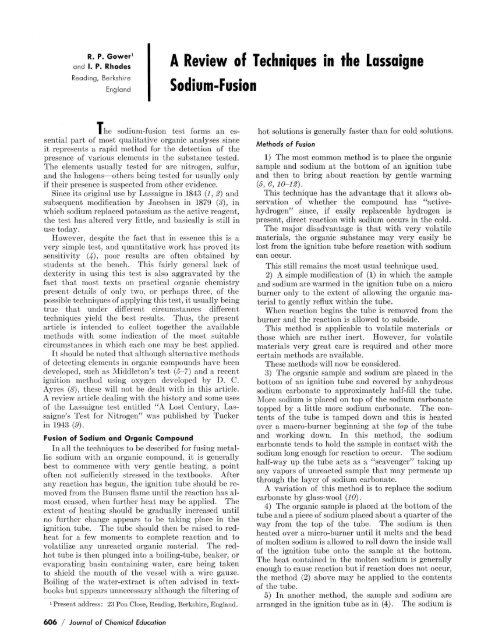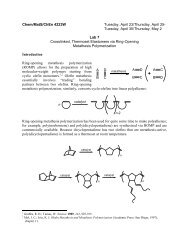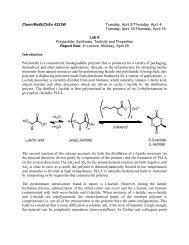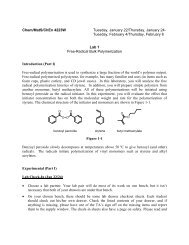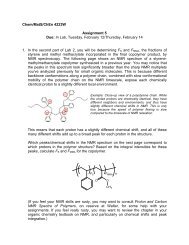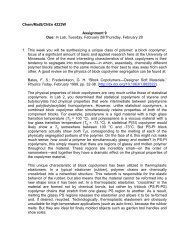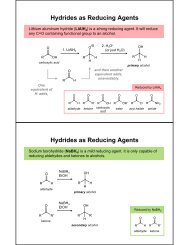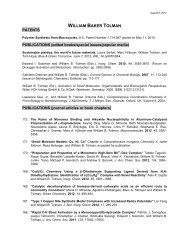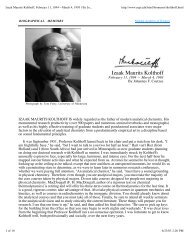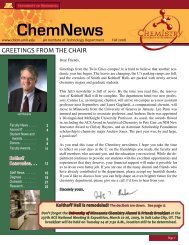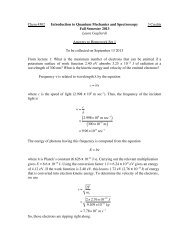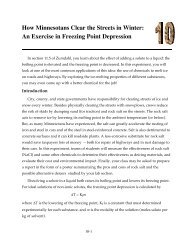A Review of Techniques in the Lassaigne Sodium-Fusion
A Review of Techniques in the Lassaigne Sodium-Fusion
A Review of Techniques in the Lassaigne Sodium-Fusion
- No tags were found...
You also want an ePaper? Increase the reach of your titles
YUMPU automatically turns print PDFs into web optimized ePapers that Google loves.
R. P. Gowerland I. P. RhodesRead<strong>in</strong>g, BerkshireEnglandA <strong>Review</strong> <strong>of</strong> <strong>Techniques</strong> <strong>in</strong> <strong>the</strong> <strong>Lassaigne</strong><strong>Sodium</strong>-<strong>Fusion</strong>The sodium-fusion test forms an essentialpart <strong>of</strong> most qualitative organic analyses s<strong>in</strong>ceit represents a rapid method for <strong>the</strong> detection <strong>of</strong> <strong>the</strong>presence <strong>of</strong> various elcments <strong>in</strong> <strong>the</strong> substance tested.The elements usually tested for are nitrogen, sulfur,and <strong>the</strong> halogens-o<strong>the</strong>rs be<strong>in</strong>g tested for usually onlyif <strong>the</strong>ir presence is suspected from o<strong>the</strong>r evidence.S<strong>in</strong>ce its orig<strong>in</strong>al use by <strong>Lassaigne</strong> <strong>in</strong> 1843 (1, 2) andsubsequent modification by Jacobsen <strong>in</strong> 1879 (S), <strong>in</strong>which sodium replaced potassium as <strong>the</strong> active reagent,<strong>the</strong> test has altered very little, and basically is still <strong>in</strong>use today.However, despite <strong>the</strong> fact that <strong>in</strong> essence this is avery simple tcst, and quantitative work has proved itssensitivity (4), poor results are <strong>of</strong>ten obta<strong>in</strong>ed bystudents at <strong>the</strong> bench. This fairly general lack <strong>of</strong>dexterity <strong>in</strong> us<strong>in</strong>g this test is also aggravated by <strong>the</strong>fact that most t.exts on practical organic chemistrypresent details <strong>of</strong> only two, or perhaps three, <strong>of</strong> <strong>the</strong>possible techniques <strong>of</strong> apply<strong>in</strong>g this test, it usually be<strong>in</strong>gtrue that under different circumstances differenttechniques yield <strong>the</strong> best results. Thus, <strong>the</strong> presentarticle is <strong>in</strong>tended to collect toge<strong>the</strong>r <strong>the</strong> availablemethods with some <strong>in</strong>dication <strong>of</strong> <strong>the</strong> most suitablecircumstances <strong>in</strong> which each one may be best applied.It should be noted that although alternative methods<strong>of</strong> detect<strong>in</strong>g elements <strong>in</strong> organic compounds have beendeveloped, such as Middleton's test (5-7) and a recentignit,ion method us<strong>in</strong>g oxygen developed by D. C.Ayres (a), <strong>the</strong>se will not be dealt with <strong>in</strong> this article.A review article deal<strong>in</strong>g with <strong>the</strong> history and some uses<strong>of</strong> t,he <strong>Lassaigne</strong> test entitled "A Lost Century, <strong>Lassaigne</strong>'sTest for Nitrogen" was published by Tucker<strong>in</strong> 1943 (9).<strong>Fusion</strong> <strong>of</strong> <strong>Sodium</strong> and Organic CompoundIn all <strong>the</strong> techniques to be described for fus<strong>in</strong>g metallicsodium with an organic compound, it is generallybest to commence with very gentle heat<strong>in</strong>g, a po<strong>in</strong>t<strong>of</strong>ten not sufficiently stressed <strong>in</strong> <strong>the</strong> textbooks. Afterany reaction has begun, <strong>the</strong> ignition tube should be removedfrom <strong>the</strong> Bunsen flame until <strong>the</strong> reaction has almostceased, vhen fur<strong>the</strong>r heat may be applied. Theextent <strong>of</strong> heat<strong>in</strong>g should be gradually <strong>in</strong>creased untilno fur<strong>the</strong>r change appears to be tak<strong>in</strong>g place <strong>in</strong> <strong>the</strong>ignit,ion tube. The tube should thcn be raised to redheatfor a few moments to complete reaction and tovolatilize any unreacted organic material. The redhottube is <strong>the</strong>n plunged <strong>in</strong>to a boil<strong>in</strong>g-tube, beaker, orevaporat<strong>in</strong>g bas<strong>in</strong> conta<strong>in</strong><strong>in</strong>g water, care be<strong>in</strong>g takento shield <strong>the</strong> mouth <strong>of</strong> <strong>the</strong> vessel with a wire gauze.Boil<strong>in</strong>g <strong>of</strong> <strong>the</strong> water-extract is <strong>of</strong>ten advised <strong>in</strong> textbooksbut appears unnecessary although <strong>the</strong> filter<strong>in</strong>g <strong>of</strong>'Present address: 23 Pon Close, Read<strong>in</strong>g, Berkshire, England.hot solutions is generally faster than for cold solutions.Methods <strong>of</strong> <strong>Fusion</strong>1) The most common method is to place <strong>the</strong> organicsample and sodium at <strong>the</strong> bottom <strong>of</strong> an ignition tubeand <strong>the</strong>n to br<strong>in</strong>g about reaction by gentle warm<strong>in</strong>g(5, 6, 10-1 2).This technique has <strong>the</strong> advantage that it allows observation<strong>of</strong> whe<strong>the</strong>r <strong>the</strong> compound has "activehydrogen"s<strong>in</strong>ce, if easily replaceable hydrogen ispresent, direct reaction with sodium occurs <strong>in</strong> <strong>the</strong> cold.The major disadvantage is that with very volatilematerials, <strong>the</strong> organic substance may very easily belost from <strong>the</strong> ignition tube before reaction with sodiumcan occur.This still rema<strong>in</strong>s <strong>the</strong> most usual technique used.2) A simple modification <strong>of</strong> (1) <strong>in</strong> which <strong>the</strong> sampleand sodium are warmed <strong>in</strong> <strong>the</strong> ignition tube on a microburner only to <strong>the</strong> extent <strong>of</strong> allow<strong>in</strong>g <strong>the</strong> organic materialto gently reflux with<strong>in</strong> <strong>the</strong> tube.When reaction beg<strong>in</strong>s <strong>the</strong> tube is removed from <strong>the</strong>burner and <strong>the</strong> reaction is allowed to subside.This method is applicable to volatile materials orthose which are ra<strong>the</strong>r <strong>in</strong>ert. However, for volatilematerials very great care is required and o<strong>the</strong>r morecerta<strong>in</strong> methods are available.These methods will now be considered.3) The organic sample and sodium are placed <strong>in</strong> <strong>the</strong>bottom <strong>of</strong> an ignition tube and covered by anhydroussodium carbonate to approximately half-fill <strong>the</strong> tube.More sodium is placed on top <strong>of</strong> <strong>the</strong> sodium carbonatetopped by a little more sodium carbonate. The contents<strong>of</strong> <strong>the</strong> tube is tamped down and this is heatedover a macro-burner beg<strong>in</strong>n<strong>in</strong>g at <strong>the</strong> top <strong>of</strong> <strong>the</strong> tubeand work<strong>in</strong>g down. In this method, thc sodiumcarbonate tends to hold <strong>the</strong> sample <strong>in</strong> contact with <strong>the</strong>sodium long enough for reaction to occur. The sodiumhalf-way up <strong>the</strong> tube acts as a "scavenger" talung upany vapors <strong>of</strong> unreacted sample that may permeate upthrough <strong>the</strong> layer <strong>of</strong> sodium carbonate.A variation <strong>of</strong> this method is to replace <strong>the</strong> sodiumcarbonate by glass-wool (1 0).4) The organic sample is placed at <strong>the</strong> bottom <strong>of</strong> <strong>the</strong>tube and a piece <strong>of</strong> sodium placed about a quarter <strong>of</strong> <strong>the</strong>way from <strong>the</strong> top <strong>of</strong> <strong>the</strong> tube. The sodium is <strong>the</strong>nheated over a micro-burner until it melts and <strong>the</strong> head<strong>of</strong> molten sodium is allowed to roll down <strong>the</strong> <strong>in</strong>side wall<strong>of</strong> <strong>the</strong> ignition tube onto <strong>the</strong> sample at <strong>the</strong> bottom.The heat conta<strong>in</strong>ed <strong>in</strong> <strong>the</strong> molten sodium is generallyenough to cause reaction but if reaction does not occur,<strong>the</strong> method (2) above may be applied to <strong>the</strong> contents<strong>of</strong> <strong>the</strong> tube.5) In ano<strong>the</strong>r method, <strong>the</strong> sample and sodium arearranged <strong>in</strong> <strong>the</strong> ignition tube as <strong>in</strong> (4). The sodium is606 / Journol <strong>of</strong> Chemical Education
<strong>the</strong>n gently heated, with <strong>the</strong> tube held almost horizontally,and <strong>the</strong> vapors from <strong>the</strong> sample are allowed to passover <strong>the</strong> piece <strong>of</strong> heated sodium (13).6) A f<strong>in</strong>al method is to place <strong>the</strong> sodium only <strong>in</strong> <strong>the</strong>bottom <strong>of</strong> <strong>the</strong> ignition-tube and <strong>the</strong>n to gently heat ituntil <strong>the</strong> sodium melts. Small quantities <strong>of</strong> organicmaterial are <strong>the</strong>n added and heat<strong>in</strong>g cont<strong>in</strong>ued aftercessation <strong>of</strong> any <strong>in</strong>itial reaction (6, 7, 14).The ma<strong>in</strong> advantage <strong>of</strong> this method is that a fairlylarge quantity <strong>of</strong> sample can he added (it is easy toestimate visually how much sodium rema<strong>in</strong>s) thusgiv<strong>in</strong>g a fairly high concentration <strong>of</strong> nitrogen, etc.,if present, with subsequent ease <strong>of</strong> detection.The ma<strong>in</strong> disadvantage <strong>of</strong> <strong>the</strong> method is that withliquids crack<strong>in</strong>g <strong>of</strong> <strong>the</strong> tube can occur.Note. It appears that, particularly for highlysubstituted nitro-compounds with a low carbon content,better results are obta<strong>in</strong>ed by leav<strong>in</strong>g a little liquidparaff<strong>in</strong> or solvent naphtha (<strong>in</strong> which sodium is stored)on <strong>the</strong> sodium and this supplies sufficient carbon to forma reasonable concentration <strong>of</strong> cyanide ions (15).Notes on Test<strong>in</strong>g for Nitrogen and HalogenThe test for sulfur with sodium nitroprusside is notdealt with s<strong>in</strong>ce this is a very sensitive test and seldomleads to erroneous results-unless solutions become contam<strong>in</strong>atedwith sulfur <strong>in</strong> which case a positive result isobta<strong>in</strong>ed when sulfur is <strong>in</strong> fact absent!Test for NitrogenThis usually <strong>in</strong>volves boil<strong>in</strong>g an alkal<strong>in</strong>e sample <strong>of</strong><strong>the</strong> water-extract from <strong>the</strong> sodium fusion with ferroussulfate and <strong>the</strong>n cool<strong>in</strong>g and acidify<strong>in</strong>g with dilutesulfuric acid. The development <strong>of</strong> a blue coloration ora dark blue precipitat,e is confirmatory for nitrogen.It seems that <strong>the</strong> development <strong>of</strong> a blue colorationand/or precipitate <strong>in</strong> a positive test depends on pHand on temperature. With pH only just below 7, <strong>the</strong>development <strong>of</strong> coloration is <strong>in</strong>hibited. It is, thus,necessary to ensure <strong>the</strong> presence <strong>of</strong> an excess <strong>of</strong> acid.Similarly, cool<strong>in</strong>g <strong>of</strong> <strong>the</strong> solution is advisable becausedevelopment <strong>of</strong> <strong>the</strong> blue coloration appears to he <strong>in</strong>hibited<strong>in</strong> hot solutions.Test for HalogenThis is straightforward if sulfur and nitrogen areabsent but even so should cause little difficulty whenei<strong>the</strong>r or both are present <strong>in</strong> solutions. It must heremembered that <strong>the</strong> solution should always be acidifiedwith nitric acid and if method (3) has been used, <strong>the</strong>solution must he boiled with excess nitric acid to ensurecomplete destruction <strong>of</strong> sodium carbonate.The chief difficulty arises when cyanide or sulfideions are present and <strong>the</strong>se are removed by boil<strong>in</strong>g <strong>in</strong>acid solut,ion. The problem is that <strong>the</strong> use <strong>of</strong> toovigorous conditions also tends to remove any halideions present. Thus, to avoid loss <strong>of</strong> halide ions, acidificationshould be with DILUTE nitric acid and <strong>the</strong>solution boiled to approximately half its orig<strong>in</strong>alvolume. The use <strong>of</strong> concentrated nitric acid shouldbe avoided.Note. If a good result is obta<strong>in</strong>ed for nitrogen, this<strong>in</strong>dicates a thorough fusion and <strong>the</strong> presence <strong>of</strong> a highconcentration <strong>of</strong> cyanide ions. Thus, if halide ions arealso present it may be expect,ed that a high concentration<strong>of</strong> halide ions will he present and with silver nitratea dense precipitate <strong>of</strong> silver halide will be obta<strong>in</strong>ed.If only a fa<strong>in</strong>t halide test is obta<strong>in</strong>ed, removal <strong>of</strong> <strong>the</strong><strong>in</strong>terfer<strong>in</strong>g ions should he repeated, first under milderconditions (e.g., boil<strong>in</strong>g for a shorter period <strong>of</strong> time oruse <strong>of</strong> wealcer acid) and <strong>the</strong>n under stronger conditions(e.g., boil<strong>in</strong>g <strong>the</strong> solution to a smaller volume or use <strong>of</strong>more concentrated acid). The results should <strong>in</strong>dicatewhe<strong>the</strong>r <strong>the</strong> fa<strong>in</strong>t precipitate with silver nitrate resultedfrom cyanide ionr, that had not been destroyedor from halide ions.ConclusionsThis article is based on difficulties experienced by<strong>the</strong> authors when us<strong>in</strong>g <strong>Lassaigne</strong>'s test. The methodsdescribed above have been tried and are generally foundto work under <strong>the</strong> circumstances <strong>in</strong>dicated hut anyparticular preference for certa<strong>in</strong> methods is a matterfor each operator to decide for himself.AcknowledgmentThe authors would like to thank Dr. I. L. F<strong>in</strong>ar,Senior Lecturer <strong>in</strong> Organic Chemistry at Nor<strong>the</strong>rnPolytechnic London, for advice and encouragement receivedconcern<strong>in</strong>g this article.Literature Cited(1) LASSAIGNE, J. L., Annalm, 48, 367 (1843).(2) LAXSAIGNE, J. L., Cmpt. Rend. Hebdousadaires des Seancesde L'Acadamie des Science, 16, 387 (1843).(3) JACOBSEN, 0.) Ber., 12, 2318 (1879).(4) MULLIXEN, S. P., AND GABRIEL, G. L., Orig<strong>in</strong>al eommunication-8thIntern. Congr. <strong>of</strong> Appl. Chem., 6, 208 (1912);reference obta<strong>in</strong>ed from Chem. Abs. 6, 3094 (1912).(5) HAYNES, B., "Qualitative Organic Analysis," MacMillan.London, 1966.(6j MANN, F. G., AND SAUNDERS, B. C., "P~actical OrganicChemistrv." (3rd ed.). Lonemans. Green. London. 1952.- -- ., ...(8) AYRES, D. C., J. CHEM. EDUC., 42,270 (1965).(9) TUCKER, S. H., J. CHEM. EDUC., 22,212 (1043).(10) CHERUNIS, N. D., AND ENTRIKIN, J. B., "Semimicro QualitativeOrganic Analysis," T. Y. Crowell, Co., New York,lo*" .7=..(11) LINSTEAD, R. P., AND WEEDON, B. C. L., "QualitativeOrganic Chemical Analysis," Butterworth, London, 1956.(12) OPENSHAW, N. T., "Laboratory Manual <strong>of</strong> QualitativeOrganic Analysis," Cambridge University Press, Cambridge,England, 1955.(13) Bann~, W. J., PhD, BSc, LRAM, Private Communication.(14) FIESER, L. F., "Experiments <strong>in</strong> Organic Chemistry," D. C.Healh and Co., New York, 1935.(15) HUDSON, H. R., PhD, BSc, FRIC, Private communication.Volume 46, Number 9, September 1969 / 607


